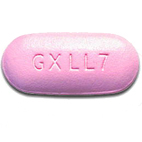
| Fosamprenavir
(Lexiva) Is Equally Effective with a Lower 100 mg Ritonavir (Norvir) Boosting
Dose HIV treatment guidelines recommend that protease inhibitors (PIs) should be used with a small amount of ritonavir (Norvir) in order to "boost" levels of the main PI in the body. However, ritonavir is associated with a variety of side effects, including elevated blood lipid levels.
LESS is More In the open-label Phase 3b LESS trial (Lexiva Simplification Study), patients who achieved HIV suppression < 400 copies/mL for at least 3 months while taking a fosamprenavir regimen boosted with 200 mg ritonavir (once-daily [QD] 1400/200 mg or twice-daily [BID] 700/200 mg) were randomized 2:1 to either decrease their ritonavir dose to 100 mg or continue on the original regimen. The 209 participants included in the intent-to-treat population were mostly men (about 80%), 67% were white, the median age was 44 years, and the median CD4 count was about 435 cells/mm3. The most common nucleoside/nucleotide reverse transcriptase (NRTI) backbone was abacavir (Ziagen) + lamivudine (3TC; Epivir) at about 45%, followed by tenofovir (Viread) + emtricitabine (Emtriva) at about 25%, and zidovudine (AZT; Retrovir) + lamivudine at about 19%. Results
These
findings led the investigators to conclude that, "A regimen of fosamprenavir
1400 mg + ritonavir 100 mg demonstrated non-inferiority to full boosted fosamprenavir/ritonavir
(700/100 mg BID or 1400/200 mg QD) over a 24 week period in virologically stable
subjects." Long-term Safety and Efficacy at 96 Weeks In a related study, COL100758, researchers compared the safety and efficacy of 100 vs 200 mg doses of ritonavir to boost 1400 mg once-daily fosamprenavir; in this trial, all patients received abacavir/lamivudine as their NRTI backbone. This randomized, open-label trial enrolled 115 participants. Most (81%) were men, 53% were black, 41% were white, 16% were Hispanic/Latino, and the median age was 39 years. The median baseline CD4 count was higher in the 100 mg ritonavir arm (259 vs 179 cells/mm3). Results
Orlando Immunology Ctr., Orlando, FL; North Texas ID Consultants, Dallas, TX; Comprehensive Care Ctr., Ft. Lauderdale, FL; GlaxoSmithKline, Durham, NC, Duke Univ., Durham, NC. Fat and Bone Mineral Density In another analysis of the same study, researchers compared changes in regional fat and bone mineral density (BMD) at 96 weeks. Total body DEXA scans were performed pre-treatment and at week 96; 113 patients had at least 1 scan, and 71 had paired baseline and week 96 scans (40 in the 100 mg ritonavir arm and 31 in the 200 mg arm). Median percentage changes in fat in the upper and lower limbs and trunk, and median percentage changes in total body and lumbar spine BMD were assessed. Clinically relevant changes in fat mass were defined as > 20% loss of limb fat and/or > 20% gain in trunk fat. Results
After 96 weeks treatment with once-daily fosamprenavir plus abacavir/lamivudine, "both limb and trunk fat depots generally increased," the researchers concluded. However, "[t]he median [percentage] change in fat mass in all regions studied was not significantly different" between the ritonavir 100 mg and 200 mg arms. Finally, they noted, "BMD changes were small in both study arms." Univ
of NC, Chapel Hill, NC; Orlando Immun. Ctr., Orlando, FL; North Texas ID Consultants,
Dallas, TX; Comprehensive Care Ctr., Ft. Lauderdale, FL; GlaxoSmithKline, Research
Triangle Park, NC; Duke Univ, Durham, NC. References C Cohen, E DeJesus, A Lamarca, and others. Switching from a 200mg-Ritonavir (RTV, r)-Boosted Fosamprenavir (FPV) Regimen (700mg/200mg BID or 1400mg/200mg QD) to a 100mg RTV-Boosted FPV Regimen (1400mg/100mg QD) Yields Similar Efficacy and Safety. 48th International Conference on Antimicrobial Agents and Chemotherapy (ICAAC 2008). Washington, DC. October 25-28, 2008. Abstract H-1250e. E DeJesus, l Sloan, M Sension, and others. 96-Week Efficacy/Safety Data Comparing Two Doses of Ritonavir (/r) to Boost Once-Daily (QD) Fosamprenavir (FPV), Used in Combination with Abacavir (ABC)/Lamivudine (3TC). 48th International Conference on Antimicrobial Agents and Chemotherapy (ICAAC 2008). Washington, DC. October 25-28, 2008. Abstract H-1246. DA Wohl, E DeJesus, L Sloan, and others. Fat changes by total body DEXA after 96 weeks of treatment with once-daily fosamprenavir with either 100 or 200 mg of ritonavir plus abacavir/lamivudine: COL10075. 48th International Conference on Antimicrobial Agents and Chemotherapy (ICAAC 2008). Washington, DC. October 25-28, 2008. Abstract H-2302. Other
source |
The
material posted on HIV and Hepatitis.com about ICAAC 2008 and IDSA 2008 is not
approved by nor is it a part of ICAAC 2008 or IDSA 2008. |
![]()
 At
the
At
the